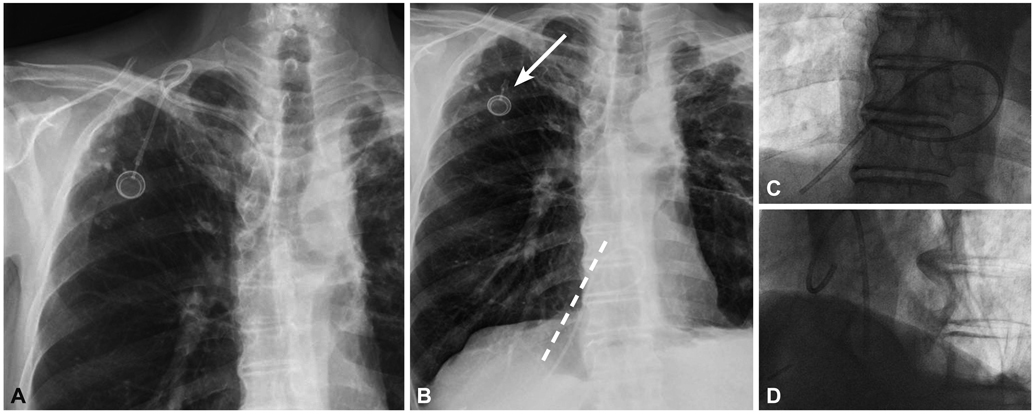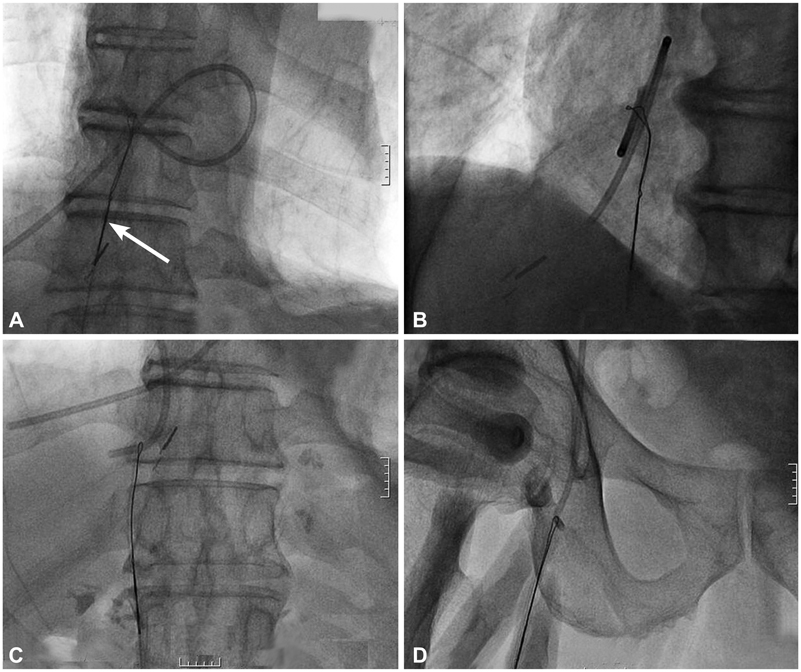Korean Circ J.
2012 Feb;42(2):122-124. 10.4070/kcj.2012.42.2.122.
Percutaneous Retrieval of an Embolized Central Venous Chemoport in a Patient With Colon Cancer
- Affiliations
-
- 1Regional Cardiovascular Disease Center, Chungbuk National University Hospital, Cheongju, Korea. drcorazon@hanmail.net
- 2Department of Internal Medicine, Chungbuk National University Hospital, Cheongju, Korea.
- KMID: 1826385
- DOI: http://doi.org/10.4070/kcj.2012.42.2.122
Abstract
- The central access device is commonly used as a route of chemotherapuetic agents in patients with malignant diseases for its convenient and safety for insertion. This report describes a case of 66-year-old man with colon cancer who suffered a rare complication in which a chemoport embolized into the inferior vena cava and it was successfully retrieved by a percutaneous approach using a goose neck snare.
Keyword
MeSH Terms
Figure
Reference
-
1. Fazeny-Dörner B, Wenzel C, Berzlanovich A, et al. Central venous catheter pinch-off and fracture: recognition, prevention and management. Bone Marrow Transplant. 2003. 31:927–930.2. Mirza B, Vanek VW, Kupensky DT. Pinch-off syndrome: case report and collective review of the literature. Am Surg. 2004. 70:635–644.3. Rauthe G, Altmann C. Complications in connection with venous port systems: prevention and therapy. Eur J Surg Oncol. 1998. 24:192–199.4. Yildizeli B, Laçin T, Baltacioğlu F, Batirel HF, Yüksel M. Approach to fragmented central venous catheters. Vascular. 2005. 13:120–123.5. Andris DA, Krzywda EA. Catheter pinch-off syndrome: recognition and management. J Intraven Nurs. 1997. 20:233–237.6. Aitken DR, Minton JP. The "pinch-off sign": a warning of impending problems with permanent subclavian catheters. Am J Surg. 1984. 148:633–636.7. Hinke DH, Zandt-Stastny DA, Goodman LR, Quebbeman EJ, Krzywda EA, Andris DA. Pinch-off syndrome: a complication of implantable subclavian venous access devices. Radiology. 1990. 177:353–356.8. Denny MA, Frank LR. Ventricular tachycardia secondary to port-a-cath fracture and embolization. J Emerg Med. 2003. 24:29–34.9. Whitman ED. Complications associated with the use of central venous access devices. Curr Probl Surg. 1996. 33:309–378.10. Andris DA, Krzywda EA, Schulte W, Ausman R, Quebbeman EJ. Pinch-off syndrome: a rare etiology for central venous catheter occlusion. JPEN J Parenter Enteral Nutr. 1994. 18:531–533.11. Nace CS, Ingle RJ. Central venous catheter "pinch-off" and fracture: a review of two under-recognized complication. Oncol Nurs Forum. 1993. 20:1227–1236.12. Fisher RG, Ferreyro R. Evaluation of current techniques for nonsurgical removal of intravascular iatrogenic foreign bodies. AJR Am J Roentgenol. 1978. 130:541–548.13. Gowda MR, Gowda RM, Khan IA, et al. Positional ventricular tachycardia from a fractured mediport catheter with right ventricular migration: a case report. Angiology. 2004. 55:557–560.
- Full Text Links
- Actions
-
Cited
- CITED
-
- Close
- Share
- Similar articles
-
- Interventional Treatment of Chemical Pleuritis and Hemothorax Caused by Iatrogenic Internal Jugular Vein Perforation after Central Venous Port System Implantation: A Case Report
- Successful Removal of a Migrated Catheter of Chemoport in Right Atrium
- Two Cases of Fractured and Embolized Implanted Central Venous Chemoports in Lung Cancer
- A case of a fractured and impacted central venous chemoport in a patient with stomach cancer
- Radiologic Interventional Retrieval of Retained Central Venous Catheter Fragment in Prematurity: Case Report



